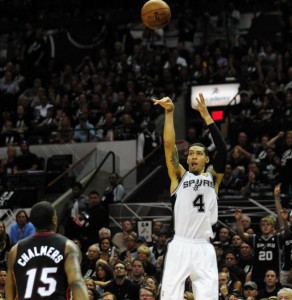Although my teaching schedule has blissfully allowed me to watch every minute of the NBA Finals — the games are on at 9 am here in Dalian, and my classes are mainly in the afternoons — it’s also June: time to make up for past marking sins, time for administrivia and visas and social obligations, time to prepare for a Canadian summer. I haven’t written a thing about the Spurs versus the Heat, and Game 6 is already upon us. Xiaoqiang is here, and the TV is warming up. I’m thinking about Danny Green.

Green from downtown San Antonio. Slightly weird, shoulder-hunching, forward-leaning shot prep, but lovely finish, and such Spur-red *confidence*.
Surely this journeyman, waived by the sadsack Cleveland Cavaliers as recently as 2011, will “regress to the mean” today in Miami, and in a possible game 7, as the Heat play the underdog role they are so ill-suited to play, by superstar temperament and by municipal glitz. Surely Green can’t continue to shoot three-pointers at the stunning rate he has so far, already bombing the record number for Finals threes — in two fewer games than Heat hired gun Ray Allen used to set the record, back in the days when he was, lo, a green-to-the-core Celtic. (Such is sports business: most history-starved hoops noodles think of Allen as a Celtic, ignoring that his Boston sojourn was shorter than his career in Milwaukee and only a year longer than his time as a Seattle Supersonic, ‘member them?) Surely there’s no way Danny Green can keep this phenomenal scoring binge going, but how is he doing it in the first place?
This could be part of a much longer post about the brilliance of the San Antonio Spurs organization. They have continuity, with Coach Popovich at the reins for 16 years when no other NBA coach has held on to his job for more than eight, and a core of players that the league punditocracy has been urging should be “blown up” for the last five years. (To Tim! To Tony! To Manu!) They believe in character and camaraderie. They pass the ball, and they move without it — their style of play is a blessing and a relief for old coaches like me. Andman,do they coach and develop the guys they have, and here’s where we get to the lessons of Danny Green.
I don’t know where, among the tsunami of game reports and breathless “THIS IS BIG” commentary I’ve read, this comes from. (I’m only 98.6% sure it was Green.) Asked how he had prospered so mightily in San Antonio after NBA struggles and time playing in Europe, the Spurs shootist said, “This is the first place I’ve been where they pay more attention to what you can do than what you can’t.” Simple. Danny Green is a guard, but he doesn’t drive or dribble all that well, and he’s not much of a passer, either. But he’s tall, long, and coachable, and he’s turned into an above-average defender. Oh, and he is a brilliant catch-and-three-point-shooter if someone delivers him the ball. (Yes, and the Spurs have a renowned shooting coach. They coach their millionaires!The athletic small forward they drafted last year, a so-so shooter with an eccentric slingshot motion in college, is now second-year stopper and emerging star Kawhi Leonard, who fills it up from the corner three with a rather lovely, lovingly honed stroke.)
A long time ago, I made one of John Wooden‘s maxims from They Call Me Coach one of mine. Don’t let what you cannot do interfere with what you can. Danny Green and the Spurs have put this poetry into motion. Now it’s halftime, and the Spurs look good. (Green hasn’t attempted a single three. They are a TEAM.)
